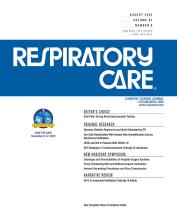This article requires a subscription to view the full text. If you have a subscription you may use the login form below to view the article. Access to this article can also be purchased.
Abstract
BACKGROUND: It remains unknown if pediatric patients failing initial noninvasive ventilation (NIV) experience worse clinical outcomes than those successfully treated with NIV or those primarily intubated.
METHODS: This was a single-center, retrospective review of patients admitted with acute respiratory failure to the University of Michigan pediatric intensive care or cardiothoracic ICUs and receiving NIV or invasive mechanical ventilation as first-line therapy.
RESULTS: One hundred seventy subjects met inclusion criteria and were enrolled: 65 NIV success, 55 NIV failure, and 50 invasive mechanical ventilation alone. Of those failing NIV, median time to intubation was 1.8 (interquartile range [IQR] < 1–7) h. On multivariable regression, ICU-free days were significantly different between groups (NIV success: 22.9 ± 6.9 d; NIV failure: 13.0 ± 6.6 d; invasive ventilation: 12.5 ± 6.9 d; P < .001 across all groups). Multivariable regression revealed no difference in ventilator-free days between NIV failure and invasive ventilation groups (15.4 ± 10.1 d vs 15.9 ± 9.7 d, P = .71). Of 64 subjects (37.6%) meeting Pediatric Acute Lung Injury Consensus Conference pediatric ARDS criteria, only 14% were successfully treated with NIV. Ventilator-free days were similar between the NIV failure and invasive ventilation groups (11.6 vs 13.2 d, P = .47). On multivariable analysis, ICU-free days were significantly different across pediatric ARDS groups (P < .001): NIV success: 20.8 + 31.7 d; NIV failure: 8.3 + 23.8 d; invasive alone: 8.9 + 23.9 d, yet no significant difference in ventilator-free days between those with NIV failure versus invasive alone (11.6 vs 13.2 d, P = .47).
CONCLUSIONS: We demonstrated that critically ill pediatric subjects unsuccessfully trialed on NIV did not experience increased ICU length of stay or fewer ventilator-free days when compared to those on invasive mechanical ventilation alone, including in the pediatric ARDS subgroup. Our findings are predicated on a median time to intubation of < 2 h in the NIV failure group and the provision of adequate monitoring while on NIV.
- pediatric
- noninvasive ventilation
- acute respiratory failure
- mechanical ventilation
- positive pressure ventilation
- clinical outcomes
- pediatric ARDS
Footnotes
- Correspondence: Heidi R Flori MD, University of Michigan C.S. Mott Children’s Hospital, Department of Pediatrics, Division of Critical Care, 1500 East Medical Center Drive, Ann Arbor, Michigan 48109. E-mail: heidiflo{at}med.umich.edu
The authors have disclosed no conflicts of interest.
Funding for statistical support was provided in kind by Department of Pediatrics Research Program, University of Michigan.
The study was performed at the University of Michigan.
- Copyright © 2022 by Daedalus Enterprises
Pay Per Article - You may access this article (from the computer you are currently using) for 1 day for US$30.00
Regain Access - You can regain access to a recent Pay per Article purchase if your access period has not yet expired.











